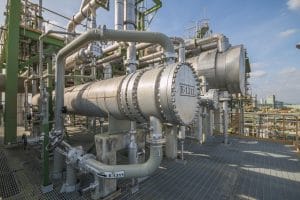 Heat exchangers have always been widely recognized as the more eco-friendly cooling solution for most electrical systems. Compared to more traditional solutions, the unique heat transfer concepts that heat exchangers use to prevent electrical overheating are much less energy and cost intensive, and they don’t allow for the release of any contaminants into the environment. However, within conventional heat exchangers, those same concepts only achieve ambient cooling, or cooling the inside of an electrical enclosure to just above the ambient temperature outside of it. While this is more than adequate for most common applications with high maximum operating temperatures, there are many different applications that require below-ambient cooling for several different reasons.
Heat exchangers have always been widely recognized as the more eco-friendly cooling solution for most electrical systems. Compared to more traditional solutions, the unique heat transfer concepts that heat exchangers use to prevent electrical overheating are much less energy and cost intensive, and they don’t allow for the release of any contaminants into the environment. However, within conventional heat exchangers, those same concepts only achieve ambient cooling, or cooling the inside of an electrical enclosure to just above the ambient temperature outside of it. While this is more than adequate for most common applications with high maximum operating temperatures, there are many different applications that require below-ambient cooling for several different reasons.
The Need for Below-Ambient Cooling
While more and more technologies (and the companies that use them) continue benefiting from ambient heat exchangers, many of them require below-ambient cooling solutions to operate at their full potential. This need can arise from several different factors. For instance, the environment may be extremely hot, making the ambient temperature outside of electrical enclosures exceed their maximum operating temperatures. Below-ambient cooling can also be essential in especially high-performing applications, such as computer processing and automated machinery. Below-ambient heat exchangers can meet the high-performance needs of such applications with the same level of efficiency and eco-friendliness that ambient heat exchangers provide to more typical applications.
Traditional Enclosure Cooling Methods
Before heat exchangers became popular below-ambient cooling solutions, companies and applications that required higher-performing thermal management had to rely on more cumbersome solutions. For example, air conditioning is designed specifically to chill electrical enclosures well below ambient temperatures, though the cost of running and maintaining multiple, industrial-sized units can become overwhelming. Air compression provided an easier to maintain solution, though the processes of compressing air and then circulating it also proved costly for companies in the long run. Fortunately, below-ambient heat exchangers have made it possible to bring those costs down significantly without sacrificing the quality of a system’s electrical thermal management processes.
The Value in Below-Ambient Heat Exchangers
While below-ambient heat exchangers are designed to achieve lower-than-ambient temperatures, their processes are similar to those of more conventional heat exchangers. Using natural forces such as phase-change cooling and cooling fluids that are chilled to the appropriate temperature, below-ambient units still rely on eco-friendly heat transfer concepts rather than complicated machinery and air conditioning/compressing methods. This means even high-performance applications can benefit from the more reliable, more efficient, and more eco-friendly thermal management capabilities of modern heat exchangers.
For more information about below-ambient cooling with eco-friendly heat exchangers, call Noren Thermal Solutions in Taylor, TX, at 866-936-6736.







